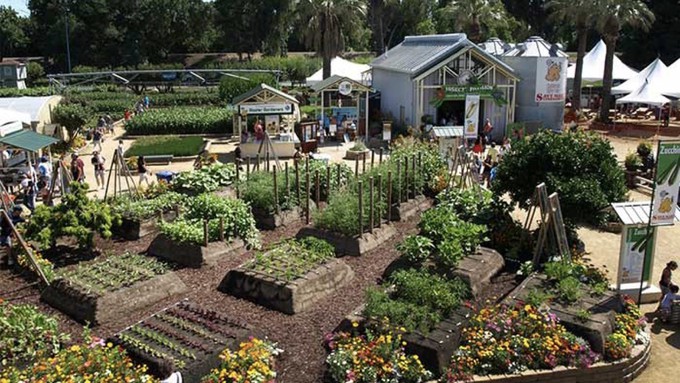
Visit master gardeners at the State Fair Farm, pet a live sturgeon

More than 70 different crops grow at the California State Fair Farm. Photo courtesy California State Fair
Of course, it’s hot! It’s time for the State Fair!
As much a Sacramento tradition as scorching summer days, the California State Fair returns Friday for its annual agricultural celebration of the Golden State.
From July 12 through 28, the fair will fill Cal Expo with such traditional favorites as nightly concerts, livestock exhibitions, horse racing and lots of food.
Also back this summer is the 3-1/2-acre California State Fair Farm, a growing display of California’s top crops.
Once again, the UC Cooperative Extension Master Gardeners of Sacramento County will be stationed at a booth in the middle of The Farm to answer patrons’ questions. Make sure to drop by and say hi.
“(At The Farm), guests are able to get a Save Mart Passport and learn about more than 70 crops grown in California, learn all about pollinators and their importance in California agriculture, as well as pet a live sturgeon in the aquaculture display,” organizers note of The Farm. “Receive water saving tips during California’s drought by visiting the water-efficient gardens sponsored by the Department of Water Resources and get gardening tips from our Master Gardeners booth.”
Many of the Farm displays are kid-friendly, with plenty of wow factor. See how kiwi grows (on vines overhead) and pint-size fruit trees with harvest in easy reach. Say the organizers, “The California State Fair Farm is an essential part of mobilizing interest for young minds to pursue a career in agriculture and to further contribute to our bountiful state and sustain the industry.”
Sacramento’s triple-digit heat is supposed to subside (at least a little) during the State Fair’s run with most days topping out in the 90s. Just in case, cooling stations will be available at several sites throughout Cal Expo. Most exhibition buildings and parts of the grandstand are air conditioned.
Cal Expo is located at 1600 Exposition Blvd., Sacramento. Fair hours are 11 a.m. to 10 p.m. Mondays-Thursdays; 10 a.m.-10 p.m. Fridays-Sundays. Online advance admission tickets are $16. Senior admission (age 62 and up) is $12; every Friday is Senior Day with $10 admission. Youth admission (ages 5-12) is $10. Children age 4 and younger admitted free. Parking: $15.
Details and advance admission tickets: https://calexpostatefair.com/.
Comments
0 comments have been posted.Sacramento Digs Gardening to your inbox.
Food in My Back Yard Series
May 6: Maintain soil moisture with mulch for garden success
April 29: What's (already) wrong with my tomato plants?
April 22: Should you stock up on fertilizer? (Yes!)
April 15: Grow culinary herbs in containers
April 8: When to plant summer vegetables
April 1: Don't be fooled by these garden myths
March 25: Fertilizer tips: How to 'feed' your vegetables for healthy growth
March 18: Time to give vegetable seedlings some more space
March 11: Ways to win the fight against weeds
March 4: Potatoes from the garden
Feb. 25: Plant a fruit tree now -- for later
Feb. 18: How to squeeze more food into less space
Feb. 11: When to plant? Consider staggering your transplants
Feb. 4: Starting in seed starting
Sites We Like
Garden Checklist for week of May 11
Make the most of the lower temperatures early in the week. We’ll be back in the 80s by Thursday.
* Plant, plant, plant! It’s prime planting season in the Sacramento area. Time to set out those tomato transplants along with peppers and eggplants. Pinch off any flowers on new transplants to make them concentrate on establishing roots instead of setting premature fruit.
* Direct-seed melons, cucumbers, summer squash, corn, radishes, pumpkins and annual herbs such as basil.
* Harvest cabbage, lettuce, peas and green onions.
* In the flower garden, direct-seed sunflowers, cosmos, salvia, zinnias, marigolds, celosia and asters. (You also can transplant seedlings for many of the same flowers.)
* Plant dahlia tubers.
* Transplant petunias, marigolds and perennial flowers such as astilbe, columbine, coneflowers, coreopsis, dahlias, rudbeckia and verbena.
* Keep an eye out for slugs, snails, earwigs and aphids that want to dine on tender new growth.
* Feed summer bloomers with a balanced fertilizer.
* For continued bloom, cut off spent flowers on roses as well as other flowering plants.
* Add mulch to the garden to maintain moisture. Mulch also cuts down on weeds. But don’t let it mound around the stems or trunks of trees or shrubs. Leave about a 6-inch-to-1-foot circle to avoid crown rot or other problems.
* Remember to weed! Pull those nasties before they set seed.
* Water early in the day and keep seedlings evenly moist.